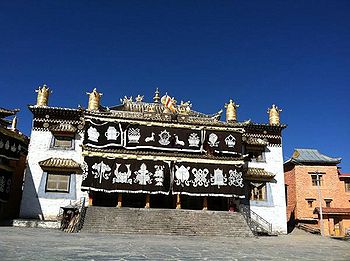Dartsang Kalzang Gompa

Dartsang Kalzang Gompa aka Kalpa Zangpo Gompa (Tib. བརྡ་ཚང་བསྐལ་བཟང་དགོན་, Wyl. brda tshang bskal bzang dgon) or 'Monastery of the Fortunate Eon'[1], is a monastery built by Dudjom Lingpa when he was 55 years old.
Location
It is located in the Li Gorge, in the Upper Do Valley of Golok, Eastern Tibet (now Serta County, Golok, Sichuan PRC), forty-two miles north of Serta county seat and less than six miles away from the Sichuan-Qinghai border[2], over 3000m above sea level. Around the monastery, the area is a vast and open nomadic pasture land, surrounded by spectacular views of high alpine meadows.
Origins
Dartsang Kalzang Gompa was founded by Yungshül Sungchok Dorjé in 1871 as a branch monastery of Taktsé Monastery (est. 1769)[3], also in Serta.[4].
Local histories record that Dudjom Lingpa became connected to Dartsang Kalzang Monastery when he was invited by Yungshül Sungchok Dorje and Tashül Tsedrupkyap to become its abbot[5].
In 1888, at the age of 54, Dudjom Lingpa moved to the Li Gorge in the Upper Do Valley. Two years later, Dudjom Lingpa built the Dartsang Kalzang Gompa, which was to become his main residence for the rest of his life. In his outer autobiography, Dudjom Lingpa recounts when he founded Kalzang Monastery[6]:
- In the first autumn month [of 1890], I received a summons from Golok, so I went there. In the year I turned fifty-six, I built Kalzang Monastery on the Lidar family.
- […]
- That same year on the eighth day of the first summer month, Dakini Sangwa Yeshe, Secret Wisdom, turned her face to me, saying, “Sublime individual, your disciple Dampa will be born in the dakini country of Orgyen on the twenty-first night of the Rabbit Month. This is certain. At the end of the Rabbit Year, go to Dodé Kalpa Zangpö Tsalgyi [ie Kalzang Monastery]. Stay there and for a while events will unfold virtuously.”
Developments
During the last decade of the nineteenth century until his death (1904), Dudjom Lingpa galvanized Dartsang Kalzang Gompa into a flourishing religious institution by building a new temple to house the complete Buddhist scriptures (the Kangyur and Tengyur) and by giving expansive teachings on his more than twenty volumes of terma revelations[7].
Dudjom Lingpa’s fame spread not only among the monastery’s practitioners in the upper Tashül region but also across the three parts of Golok.
Later, after the passing of Dudjom Lingpa, it became during the beginning of the twentieth century, the seat of several of his sons: Tulku Trimé Özer, Tulku Dorje Dradül and Tulku Lhatop.
Recent Years
Around the year 2005, a stupa dedicated to Tulku Trimé Özer was under construction around the monastery.
Main Characters
- Dudjom Lingpa
- Sera Khandro
- Tashül Tsedrupkyap
- Tulku Dorje Dradül
- Tulku Lhatop
- Tulku Trimé Özer
- Yungshül Sungchok Dorje
Notes
- ↑ Or Dartsang Kalpa Zangpo Gompa, or Dodé Kalpa Zangpö Tsalgyi
- ↑ Sarah H. Jacoby, “Love and Liberation, Autobiographical Writings of the Tibetan Buddhist Visionary Sera Khandro”, Columbia University Press, New York, USA, 2014, page 49.
- ↑ Taktsé in turn is a branch of Katok Monastery.
- ↑ Sarah H. Jacoby, “Love and Liberation, Autobiographical Writings of the Tibetan Buddhist Visionary Sera Khandro”, Columbia University Press, New York, USA, 2014, page 49.
- ↑ Sarah H. Jacoby, “Love and Liberation, Autobiographical Writings of the Tibetan Buddhist Visionary Sera Khandro”, Columbia University Press, New York, USA, 2014, page 49.
- ↑ Dudjom Lingpa, ‘A Clear Mirror’, The Visionary Autobiography of a Tibetan Master’, The Outer Autobiography, translated by Chönyi Drolma, Rangjung Yeshe Publications, 2011, p169-170.
- ↑ Sarah H. Jacoby, “Love and Liberation, Autobiographical Writings of the Tibetan Buddhist Visionary Sera Khandro”, Columbia University Press, New York, USA, 2014, page 49.